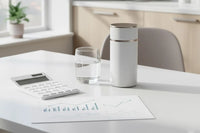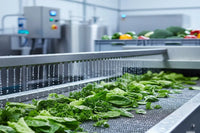Sanitizers are meant to kill pathogens—not your equipment.
But walk into any food plant that’s used bleach, PAA, ozone, or quats for more than a year, and you’ll find:
- Pitted stainless steel
- Cracked gaskets
- Warped belts
- Corroded spray heads
- Sticky nozzles
- Shortened pump lifespans
It’s easy to blame wear-and-tear, but the real culprit is often hiding in your chemical room. Sanitizers designed to kill microbes are silently killing your machines. And the damage adds up—month after month, year after year—until your CapEx budget is bleeding and your maintenance crew is buried.
Let’s reveal the true cost of traditional chemical sanitation on your equipment, and why hypochlorous acid (HOCl) is becoming the equipment-safe, corrosion-free alternative that extends hardware life while improving kill performance.
What Traditional Chemicals Do to Your Plant
🧪 Bleach (Sodium Hypochlorite)
- Highly corrosive to stainless steel (304 and 316)
- Reacts violently with organic matter, forming off-gas
- Leaves salt residue that causes pitting
- Degrades belts, seals, and plastic components
- Requires post-rinse to avoid damage—introducing more moisture and labor
🧴 Quats (Quaternary Ammonium Compounds)
- Sticky film builds up on surfaces
- Attracts dust, microbes, and water
- Leads to biofilm formation when not fully rinsed
- Increases friction on moving parts
- Breaks down rubber and flexible PVC components
⚗️ PAA (Peracetic Acid)
- Acidic pH accelerates corrosion
- Vapors damage control panels, sensors, and seals
- Strong odor permeates vents and HVAC
- Aggressively breaks down metal, silicone, and vinyl over time
🌫️ Ozone
- Extremely reactive gas
- Causes cracking of rubber gaskets
- Requires room evacuation for safety
- Degrades wiring and electronic interfaces over time
- Can oxidize coatings, filters, and fan components
The Cumulative Cost: Death by a Thousand Sanitizers
Every week of exposure chips away at your capital investment. Typical impacts:
| Component | Damage from Traditional Chemicals | Average Replacement Cost |
|---|---|---|
| Stainless surfaces | Pitting, discoloration, weld failure | $3,000–$30,000 |
| Conveyor belts | Dry rot, cracking, stretch failure | $2,000–$15,000 |
| Gaskets + seals | Shrinkage, brittleness, leaks | $500–$5,000 |
| Spray systems | Clogged nozzles, broken hoses | $1,500–$6,000 |
| Sensors + controls | Short circuits from acid or ozone vapor | $2,000–$12,000 |
| HVAC systems | Mold + corrosion from bleach/PAA fogging | $10,000–$50,000+ |
Many facilities spend $20,000–$100,000+ annually replacing parts that degrade not from use—but from chemical exposure.
HOCl: The Corrosion-Free Sanitation Alternative
Hypochlorous acid (HOCl) changes the game. Made from water, salt, and electricity, HOCl is:
- ✅ pH-neutral
- ✅ Non-corrosive to stainless, plastic, gaskets, and pumps
- ✅ Evaporates cleanly with no residue
- ✅ Safe on sensors, belts, spray heads, and electronics
- ✅ Rinse-free
- ✅ Odorless and stable when used properly
It offers hospital-grade sanitation without eating your plant alive.
How HOCl Preserves Your Assets
🚿 No Residue
HOCl leaves behind only trace salt ions and water—no sticky quats, acidic vapor, or chemical film. Result: no build-up, no equipment drag, no post-wipe, no degradation.
🛡️ Non-Corrosive to Metal
Unlike bleach or PAA, HOCl doesn’t react with:
- 304/316 stainless
- Galvanized metals
- Polymer spray nozzles
- Silicone and EPDM gaskets
That means your stainless stays stainless, your welds stay strong, and your parts last longer—up to 3x in many facilities.
🌫️ Safe for Electronics and Controls
HOCl fogs don’t carry acidic vapor or free radicals. That means:
- Sensors stay calibrated
- Control panels don’t short
- Fans and vents stay clean
- Seals don’t shrink from exposure
🧰 Less Maintenance, Fewer Shutdowns
When you reduce chemical stress on your equipment, your maintenance team gets:
- Fewer emergency calls
- Less unplanned downtime
- Longer intervals between parts replacement
- More budget to spend on proactive upgrades—not reactive patches
Real Results from Facilities Using HOCl
-
Dairy Plant – Midwest
Before: Replaced conveyor belts every 9 months due to bleach damage
After: HOCl implementation extended belt life to 2.5 years
-
Seafood Facility – Gulf Coast
Before: HVAC system corroded by PAA fog
After: HOCl fogging used daily with zero corrosion over 14 months
-
RTE Processor – Northeast
Before: Quarterly gasket failures due to quat buildup
After: No gasket replacements in 18 months post-HOCl
Final Word: Your Sanitation System Shouldn’t Destroy What You Built
Every tank, sensor, blade, belt, and pipe in your facility is a long-term investment. But if your sanitizer corrodes what it touches…
- You’re draining profits
- You’re doubling labor
- You’re shortening lifespan
- You’re stuck in a loop of maintenance and replacement
HOCl protects your investment while delivering superior microbial control. No residue. No corrosion. No compromise.
Want the Equipment-Safe Sanitation Blueprint?
📩 Download the HOCl Sanitation Blueprint, including:
- Equipment compatibility table
- Corrosion comparison charts vs bleach, PAA, ozone
- ROI calculator on part lifespan extension
- Swab SOPs and fogging protocols
- Case studies from real plants that saved $10k+ in repairs





